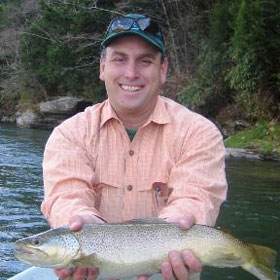The Curious Case for Tenkara
By Kirk Deeter
Sep 12, 2016
They say “what’s old is often new,” and that’s certainly the case with the trendy new style of fly fishing called “tenkara.”
They say “what’s old is often new,” and that’s certainly the case with the trendy new style of fly fishing called “tenkara.” Tenkara is actually a centuries old, traditional Japanese form of angling. And it has taken off within the United States in recent years, particularly among anglers who like to fly fish for trout.
The rods used are generally longer than the standard fly rod (12 feet or more), and they’re quite supple, designed to make delicate presentations to smaller fish (trout) in brooks and streams. Here’s the real kicker: The line is actually attached to the end of the rod itself, and it is made of a clear braided leader that tapers into a fine single strand of monofilament. The line is only slightly longer than the rod itself. There are no guides on a tenkara rod, and no reel attached to it.
So, naturally, the angler’s casting range is limited to the length of the rod and line, and it’s pretty tricky to land the fish you hook without the give and take ability of a reel. And that’s what makes tenkara fishing a blast. Most fly anglers by nature embrace challenges, otherwise we wouldn’t take up the sport in the first place. Tenkara offers plenty of challenges.
There’s another appeal to tenkara worth noting. I think a tenkara rod is the ideal teaching and training tool for the would-be fly angler. No tangled loops of fly line bunched at your feet, and no trying to gauge distances. You feel the cast evolve in a tenkara rod, and because your range is limited, you naturally develop a skill for sneaking up on fish, and being stealthy in the delivery of flies. Those attributes pay dividends for fly fishermen (and women) for a lifetime, perhaps as much as a good casting stroke will.
Tenkara rods also cost less than most fly rods, and they “telescope” down to a size that can easily be stowed and toted around. Of course, there are limits to the size of fish you can catch with a tenkara rod (though I have seen my friend Chris Hunt land a small pike and a pretty large lake trout on one, and I have caught small tarpon with a tenkara rod). But that’s kind of the point. When you can hook an 8-inch trout, or a bluegill, and it feels like a whopper, it keeps things interesting. And if you’re learning along the way, so much the better.
The rods used are generally longer than the standard fly rod (12 feet or more), and they’re quite supple, designed to make delicate presentations to smaller fish (trout) in brooks and streams. Here’s the real kicker: The line is actually attached to the end of the rod itself, and it is made of a clear braided leader that tapers into a fine single strand of monofilament. The line is only slightly longer than the rod itself. There are no guides on a tenkara rod, and no reel attached to it.
So, naturally, the angler’s casting range is limited to the length of the rod and line, and it’s pretty tricky to land the fish you hook without the give and take ability of a reel. And that’s what makes tenkara fishing a blast. Most fly anglers by nature embrace challenges, otherwise we wouldn’t take up the sport in the first place. Tenkara offers plenty of challenges.
There’s another appeal to tenkara worth noting. I think a tenkara rod is the ideal teaching and training tool for the would-be fly angler. No tangled loops of fly line bunched at your feet, and no trying to gauge distances. You feel the cast evolve in a tenkara rod, and because your range is limited, you naturally develop a skill for sneaking up on fish, and being stealthy in the delivery of flies. Those attributes pay dividends for fly fishermen (and women) for a lifetime, perhaps as much as a good casting stroke will.
Tenkara rods also cost less than most fly rods, and they “telescope” down to a size that can easily be stowed and toted around. Of course, there are limits to the size of fish you can catch with a tenkara rod (though I have seen my friend Chris Hunt land a small pike and a pretty large lake trout on one, and I have caught small tarpon with a tenkara rod). But that’s kind of the point. When you can hook an 8-inch trout, or a bluegill, and it feels like a whopper, it keeps things interesting. And if you’re learning along the way, so much the better.
Popular Posts









